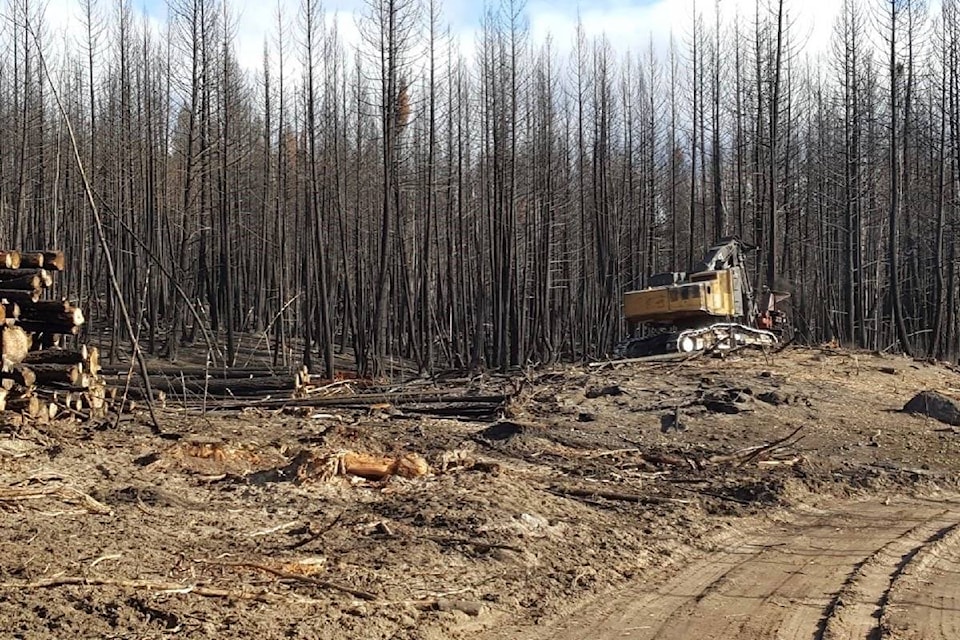By Monica Lamb-Yorski – Williams Lake Tribune
To date West Fraser has delivered approximately 3,350 truckloads of burned timber to Williams Lake and another 1,000 truckloads to 100 Mile Lumber, the company’s woods manager Mark Runge said Wednesday.
The 3,350 truckloads, or 184,000 cubic metres, is enough to supply the Williams Lake sawmill for 52 days, he said.
“Most of this volume has come from log purchase arrangements with deeded private properties in the Williams Lake area, the UBC Research Forest and the Military Reserve at Riske Creek with deliveries from our own license starting up in February.”
Almost immediately West Fraser began receiving burned wood taken from local ranches around Williams Lake.
“Some of the ranchers allowed us to put our logging contractors that would normally operate on our license onto their private property,” Runge said.
West Fraser is also purchasing burned timber from three burned BC Timber Sales in the Slater Mountain and Hawks Creek areas after break up and will be submitting more cutting permits in burned timber at the Hanceville-Riske Creek Fire area after break up as well and will continue to harvest there.
Since October the company has been processing the salvaged wood in the sawmill. A few logs made their way to the plywood plant too, he said.
“We made sure the waste veneer was made into hog fuel, which we do anyway, so it wasn’t going into chips,” Runge explained, noting there are risks to milling the burned timber because the charcoal in the residual wood is not usable for pulp.
There is also an added cost to logging burned timber because the charcoal dust on the outside of the bark of the tree gets into the logging equipment and can cause electrical shorts and fires.
Runge said anyone logging burned timber has to wash out the machinery with water every day and have a special truck with water pumps on site.
Most of the burned timber coming in is Douglas-fir and so far it has been OK to process because the wood was alive on July 7 when the wildfires broke out all over the Cariboo Chilcotin.
“The trees were all full of water when the fire came so they had moisture in them. They dried out a little bit, but the moisture was still there. We’ve been running them through the sawmill and getting good results with the lumber,” Runge said.
Eventually the wood will start to degrade as time unfolds because the burned, dead trees still standing won’t be able to draw water and the wood will start to crack.
“We will be able to recover less lumber out of it [as times goes by],” Runge said. “We won’t even attempt to get plywood out of it after break up. The plywood process is very sensitive to moisture content.”
In the long-term, Runge anticipates West Fraser will continue processing burned timber for two to three years.
“Right now we are trying to accumulate about three months worth of timber in our log yards, which we have. By mid-June we will have to start accumulating wood again.”
West Fraser’s mills at 100 Mile and Chasm are low because of a lack of cutting permits before the fires due to delays in getting them issued and a very competitive purchase wood market with other mills in the Kamloops area.
Also trying to catch up after the fires was problematic with logging truck capacity.
Runge has worked in Williams Lake for two years and before that worked in 100 Mile House.
Looking back to 2010 when there were some major wildfires in the region, Runge said one of the side effects is the fact the fires didn’t kill all Douglas-fir trees west of the Fraser River during that time, but stressed the trees enough that the fir beetles were able to get into the trees.
When asked if there are similarities to processing burned timber and Douglas-fir beetle timber, Runge said the difference is that burned trees are dead and that’s it.
“With fir beetle it’s an active forest health issue and there are actual beetles in the trees that we are trying to bring into the mill. We are trying to kill the beetle as we mill the wood.”
